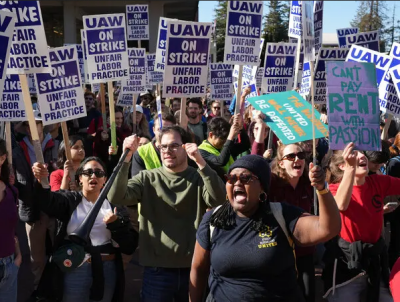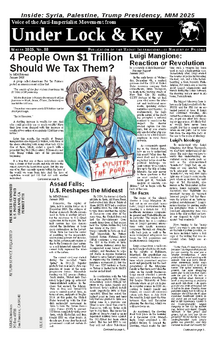
Why the Student Intifada must Outpace the Social Fascism Running Behind It

On May 13th, UAW Local 4811 voted to authorize a statewide stand-up strike across University of California campuses. Though representing largely class enemy strata, the United Auto Workers union (UAW) has, in the past few years, been an innovator in strike tactics. “Stand-up strikes,” as they are called, differ from traditional strikes by having local branches be called to the picket by a central coordinator, as opposed to having all members strike at once. This tactic reduces burnout among the strikers by introducing “shift work” into the nature of the picket, and psychologically attaches rank-and-file members more closely to movement developments with anticipation of not knowing until the day of whether it is their turn to strike.
The public response of the university administration has been traditionally liberal. Unable to argue on the moral grounds of the genocide and their active support of it, administrators displace the discussion to either the process of dissent (whether it’s “through the right channels”) or how the dissent affects the lives of settlers. After failure to challenge the legal grounds of the strike, the UC office of the President moved to pearl-clutching,
“UAW’s goals of ‘maximize chaos and confusion’ have come to fruition, creating substantial and irreparable impacts on campuses and impacting our students at a crucial time of their education.”
As of the writing of this article, all universities in the state of Palestine have been destroyed in the genocide.
The UAW represents 5,000 workers at UC Irvine, 8,000 at UC San Diego, and 3,000 at UC Santa Barbara, totaling 31,500 members for all six of the universities affected by the strikes. According to an interview conducted May 31st by The Orange County Register, “UAW Local 4811 is asking the UC schools to give amnesty to all academic employees and students who faced arrest or disciplinary actions for protesting at campuses. The union also wants the students to have guarantees of freedom of speech and political expression on campus and is asking for researchers to be able to opt out of funding sources tied to the Israeli Defense Force.”
Like much university faculty outrage across the country following the student intifada of the past few months, faculty demands have been animated by, and primarily center protecting students and staff from criminal charges, less so the criminal slaughter of civilians by the zionist entity. Even if driven by a racist instinct that the well-being of their peers are of more value than the faceless masses of the Third World, this is an interesting case study in how labor-aristocratic elements may be leveraged as an auxiliary for genuinely progressive ends.
This case study, and the many parallels of it across Turtle Island, reinforces the need for approaching international solidarity work in the imperial core with united front tactics. Were all actors on these campuses concentrated into a single organization or coalition, outrage over the arrests of students and faculty would have quickly gobbled up all the air in the discussion surrounding Palestine. Though not intentionally designed, the separation of student activists and union organizations has contributed to the success of the student intifada. As has the organic separation between faculty and students, though sometimes muddled by unionized students in the UAW. This separation has permitted, but not guaranteed, the more principled students to take initiative in fighting their local foot-soldiers of ethnic cleansing. Many have taken the opportunity to occupy key locations, destroy property facilitating genocide, or symbolically renaming liberated buildings on their campus after Martyrs slain in the liberation struggle.
So long as the student radicals keep ahead of the social fascists keen to rally around them, they can keep efforts centered on Palestine and fix these tertiary elements into a supporting role behind their initiatives, lest they be dragged down into drivel like the UAW’s campaign to hijack the movement into unionizing arms manufactures, as we reported last issue. This is only possible if the students maintain organizational independence from the forces which risk slowing them down. While united front tactics don’t guarantee success – it’s up to the students to center the right lines and pick the correct strategies to see their goals fulfilled, without it they will be tackled at the starting line. As the next school semester approaches on the horizon, we wish the student radicals the best of luck in their race against backward elements.
MIM(Prisons) adds: The “social-fascism” thesis was applied by Bolsheviks to Western Europe’s social-democracy of the late 1920s and early 1930s. Behind this thesis was MIM’s understanding of social-democracy as not always based in a politically foggy sector of the proletariat but usually in the super-profit bribed petty-bourgeoisie known as the “labor aristocracy” –at least in the imperialist countries, especially those long-established imperialist countries with colonies or neo-colonies. The “social-fascist” term applied to social-democrats who appeared socialist on the outside while serving fascism in content. MIM applies this term to all those today who appeal to the economic nationalism of the imperialist country labor aristocracy. Those calling for closing the borders, import restrictions etc. and calling themselves “socialist” or even “communist”–these are the social-fascists today.(2)
Notes: 1. read MIM
Theory 14: United Front for more theory on how to unite various
class interests
2. MC5,
5 March 2001, Book Review: Dimitrov & Stalin 1934-1943: Letters from
the Soviet Archives
Related Articles:








